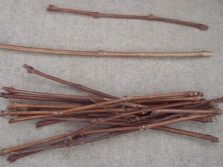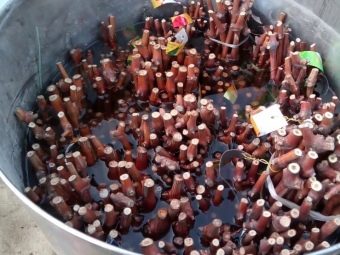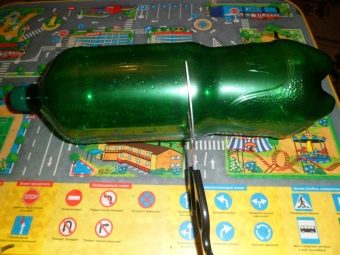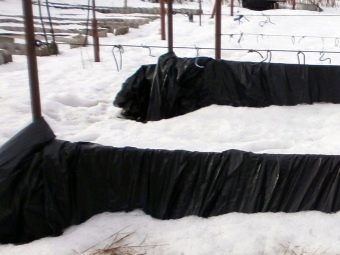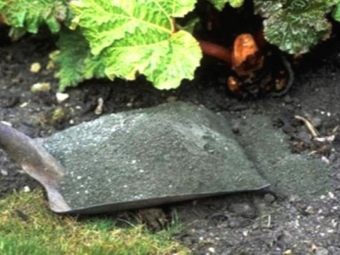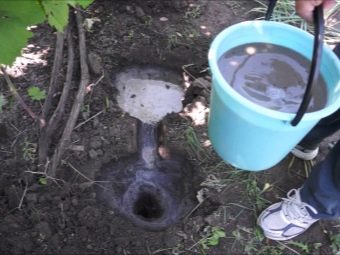How to plant grapes cuttings in the spring in the open ground?
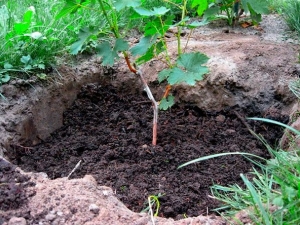
Many gardeners dream to grow southern grape varieties in their backyard. In recent years, this has become a possible event.Breeders have conducted a number of works aimed at obtaining new grape varieties. They managed by grafting to plant and force fruit in different parts of the country to grow vines that had previously grown only in regions with high solar activity.
Material procurement
After you have chosen the grapes that you want to plant at home, you need to cut the cuttings off the branches that are well fructifying. Chubuk cut from the bottom upwards with a sharp knife. The branches should be long and straight without twisting. 3-4 buds are left on each handle, and leaves or processes are removed using a secateur or a knife. The length of the shoot itself ranges from 30 to 50 cm.
In the event that you decide to germinate grape cuttings at home, and do not have a vineyard and a vine from which they will be cut, then cuttings can be purchased in the markets (in the areas of sale of seedlings). Be sure to pay attention to the storage conditions of the cuttings that you decide to buy. If they were a long time in a cold room or in the heat, then they should not be purchased.
To check the shoots for germination, it is necessary to make an incision on one of the buds. At the site of the cut should be the formation of green color on the inside of the kidney. This is proof that the branch is alive, and all metabolic processes in it are not disturbed.
Time
When autumn comes, and the yellow leaves begin to fall, the time comes for harvesting cuttings of grapes with the aim of planting them in the ground in the spring. The preparatory stage takes a period of time from September to the second decade of October.
Sprouted cuttings or seedlings are planted in the ground in different regions of Russia in the following months:
- in the areas of the Southern Federal District (Stavropol and Krasnodar Territory) in March or April;
- in the Central region, the planting of grape cuttings takes place in April and May;
- in the northern parts of the country they are planted in the ground in June.
Technology
Cut cuttings must be placed in the settled water in order to moisten the vine. In order to avoid various bacteria and diseases, it is best to treat the branches with fungicides. After the procedure, they are dried.
In order to plant the cuttings in the ground in the spring, they should be placed in a cool place with a low positive temperature for a while. Every home has such an optimal place. This is a fridge.
Pre-shoots need to be wrapped in cloth and then covered with a film of polyethylene, folded them in the remote compartment of the refrigerator.
At the end of December or at the beginning of January, the cuttings should be taken from the place of their storage and placed in a separately prepared PET bottle for germination. In this case, the bottle is pre-cut at a height of 2/3 of its total length. Water is poured into it at a height of 2.5-3 cm and the cutting is immersed. There is a method Radchevsky, following which the cuttings are kept in water for 3 days. Then the water is drained and immersed in a solution of water and honey. On a bucket of water put 1 tablespoon of honey, and this composition fills each bottle with the handle to the previous height of 3 cm from the base of the tank.
Then put the bottle in a well-lit place, and wait for the appearance of the roots. The evaporating water is poured evenly throughout the entire period of germination of the shoots. The cuttings treated in this way germinate very quickly - within 10-14 days.
Landing features
Spring planting of grapes with chubuki in the ground begins with the transplant of cuttings in bottles with water.
First, germinated sprigs of grapes need to be planted in bottles of soil. Finally, it will be possible to plant them in the ground on the plot after the formation of strong shoots with well-developed branches.
In order to properly plant cuttings in bottles with soil, it is first necessary to prepare the container, the soil, drainage and water for irrigation.
Step by step to plant sprouted twigs can be as follows.
- Drainage is placed in a clean PET bottle, cut in a circle at the top. It can be purchased at a specialist store for plants or on the market. Drainage is filled to the bottom of the bottle.
- After this, a container filled with earth is taken, and a tablespoon begins to pour the soil into the bottle with drainage. The land in the tank must be at least half of its volume.
- When the ground is filled, carefully take the handle with the roots and place it from one bottle to the other. They hold it with the left hand, and with the right hand they continue to fill the remaining space in the bottle with earth. After 3-4 cm to the top of the bottle, the ground is tamped with fingers around the cutting and watered.
- Then the soil is poured into the bottle, so that 1.5-2 cm is left up to the top of the bottle. In this way, you can plant all the cuttings of the grapes that were previously germinated in water bottles. The cuttings transplanted in ground containers are left to germinate.
- Cuttings are planted in the ground when the soil is heated to +15 degrees Celsius to a depth of 25 cm.
- Dig holes. In each of them put a drainage in the form of stones. After that, they put some earth on them. The seedlings removed from the cut bottles are carefully placed in the pits to a height of 40 cm. At the same time, on the surface of the soil, after the hole is filled, the bud should remain, above it, and the leaves on its top. The left hand is held onto the cutting (sapling), and the right hand is poured on the ground around it until it remains 5-7 cm to the ground level on the site. Then they tamp the area around the cutting with their fingers and water the landing site.
- After the watering is completed, the hole is filled up until it is completely filled with earth. Next, carry out the mulching of the soil around the planted cutting. Mulch the land can be barley. Take his seeds and strew them around the seedling. On top of them a little more sprinkled with earth. It is recommended to mulch the soil in such a way that the grape root system breathes well and develops. When the barley germinates, it is pulled out, and thin holes remain in the soil through which oxygen passes well to the roots of the cuttings. In this process of planting germinated cuttings in the ground ends.
Plant preparation
When the winter cold weather is over, and the soil warms up to + 10 ... 15 degrees Celsius, the grapes sprouted in the bottles prepare to be planted in open ground. The bottle is incised with scissors in several places from top to bottom to its base. This will provide an opportunity to extract the sprouted seedling without damaging it. Before planting, the roots of the Chubuki are shortened a little, cutting them. In the future, the growth of vines planted in the ground, will accelerate.
Place and ground
Before proceeding to the planting of grape cuttings in the ground, carefully select a place to plant, and prepare the soil.
The plot where grapes are planted should be very well lit. Drafts and the availability of groundwater nearby are not welcome. Vines love space, actively grow on free plantations, so the place should be chosen as far as possible from other vegetable or fruit plants. Planting grapes cuttings should be carried out at a distance of at least 2.5-3 meters from them. The presence near the trees also adversely affects the growth of the vines. Trees with their roots take nutrients from the soil, and at close proximity will drown the growth of cuttings.
The soil for planting grapes in spring is prepared in the fall. For the active growth of vines need light and fertile soil. Black earth is best suited for this purpose.
Depth and distance
It is important to remember that different grape varieties require different distances between rows of vines. Grade grade and soil fertility have a huge impact on the width between rows.
If the soil is saturated with nutrients, then there is a likelihood that the planted cutting will quickly develop into a huge grape bush, which will occupy a large area.
It is believed that for successful growth, the vines must be planted from each other at a distance of 2.8-3 meters.
The aisle at the same time covers an area of 2.5 to 3 meters.
Vigorously growing grape varieties, such as "Isabella", "Lydia", should be planted at a distance between the rows of up to 3.5-4 meters. Between cuttings should be left up to two meters.
Cuttings of grape varieties that do not grow very actively, or belong to the category of low-growing crops, should be planted at a distance of one meter from each other and keep a pitch of 1.2-1.5 meters between rows.
Depending on how many cuttings you want to plant in the ground, and what kind of grapes to use as a basis, you need to determine for yourself whether you will use trellis. Sprouted cuttings need support, for which he will catch the antennae for further growth.
If grape cuttings are planted not around the gazebo or the wall along which they begin to reach upwards, but on a garden plot of several square meters, then it is best to use trellis. These are stable poles that are connected to each other by means of ropes. Ropes pull parallel to the ground. Make them yourself will not present difficulties.
When using high-growing grape varieties, cuttings can be planted at a short distance from each other, within 1 meter.
We must not forget about the fact that for the winter the vines are dropping or tilted to the ground and wrapped. For this you need a place near each bush that grew from a cutting. Planting cuttings at too close a distance from each other will hinder their growth and development, and in the end will significantly reduce yields from each bush. The hole (hole) for planting a cutting in it must be dug 50 cm deep into the ground.
Fertilization
In late summer or early September, the soil is fertilized for planting grapes. Soil with acidity should be fertilized with limestone. If there is peat in the soil, then it is best to add sand to it. As other fertilizers use potassium sulfate, humus, superphosphate. They carry out the fertilization of the soil in the proportions and volumes indicated on the packaging bags in which these substances go on sale. After fertilization, the soil is carefully excavated and no more preparatory activities are carried out until spring arrives. When the cuttings have been planted in the ground in spring, the time begins for feeding them.
Cuttings must be fertilized with mullein during the first half of the summer to mid-July. From July 20, the soil should be fertilized with bird droppings.
If inorganic fertilizers are used, then in June fertilizing is carried out with superphosphate. Prepare a solution at the rate of 200 grams of the substance in 2.5-3 liters of water.
After it is combined with a solution prepared from potassium, ammonium nitrate and boric acid. Nitrate take 30 grams, potassium 100 grams, acids 10 grams, and dissolve these substances in two liters of water. Then the solutions are mixed.
Mixed solutions are diluted with water in a volume of 10 liters.
This prepared composition makes spraying grape leaves on both sides. The procedure should be carried out in the evening or overcast weather.
At the end of July or at the beginning of August, it is necessary to make another feeding of grape shoots. The solution is prepared according to the same rules as the first time. The only difference is that ammonium nitrate is removed from the composition, and superphosphate and potassium are left at the same dosage.
Ways
There are several ways to fertilize. Each of them has its advantages and disadvantages.
- In the spring before planting cuttings in the ground, you can fertilize the entire area of the land plot selected for their planting.With this method of fertilizing the soil, the consumption of fertilizers themselves is quite large, since the entire plantation is fertilized.
- Fertilization under each bush is a time consuming process, but an effective method. In contrast to the first method, fertilizers fall directly on the root system, and not on the soil nearby. With this method, nutrients fall only in the area of the bush, and not on the weeds growing around.
- Top dressing of vines can be done by spraying them with weak fertilizer formulations. This method is good because already after several hours the grapes get the elements necessary for its growth and vital activity. When spraying, the amount of fertilizer used is saved. Disadvantages in the work may be caused by the need to process large plantations with this method. The sprayer should be modern, allowing to handle large areas of the site. When using a small-sized sprayer up to 1 liter, it will be difficult to manually fertilize a vine plantation.
Spraying treatment should be carried out in dry weather in the early morning or in the evening when there is no solar activity.
- Fertilizer can be applied with water used for irrigation. Fertilizers (tuki) are immediately dissolved in water and at the same time irrigated, they feed the grapes. With this method, with the water to the roots of the planted cuttings receive nutrients. Fertilizers with this method are consumed in small quantities, and there is no need to purchase a sprayer for irrigation. All the work done by hand. The disadvantage of this method of treatment (feeding) is that water is consumed much more than when using other methods. After watering with a solution with fertilizers, it is necessary to water all the grape chibukhs once more, so that the water with the dissolved substances on them is placed on the glass leaves.
Secondary watering will protect the leaves from possible burns.
Common mistakes
Beginning winegrowers often make mistakes when landing cuttings in the ground.
Among their diversity, there are 6 main actions that affect the growth and fruiting of vines.
The first mistake is that the cutting is finely planted in the ground. The main branch, from which shoots grow, is located high above the ground. Vine, located high above the ground, it is impossible to bend down to the soil in the autumn and to cover it for the winter. Moreover, it is impossible to prikopat such a vine in the ground, so that it survived the winter cold. The main root, from which the branch leaves, must be buried in the ground when planting below the ground level, where the hole is made.
Most gardeners make the second mistake. They spend frequent watering the vines. Waterlogging leads to the fact that oxygen starvation begins at the roots of the cuttings. On the surface of the soil a kind of crust of earth forms, and it does not allow the roots to breathe in full force. As a result, growing sickly vine.
Watering should be carried out 1 time in 2 weeks, but watering is very abundant. Under each bush must be poured from 4 to 5 buckets of water.
The third violation is the failure of the pasyncracy. From the stalk grow lush bushes. In the axils of the main leaflets, shoots grow with several leaves. Such growths must be removed. If you do not break off extra branches on the main vine, then it does not receive all the vital elements. Paceniks take away all her food from her, and the main grape branch grows with a weak shoot. Hope for high yields of grapes in this case is impossible.
The fourth mistake gardeners such. Planted grape cuttings do not treat diseases. Among the most common of them are gray and white rot, mildew, anthracnose. Anthracnose, for example, destroys the foliage, the shoots themselves, affects the berries.
In particular, anthracnosis is treated with such drugs as "Thanos", "Antracol", "Kuproksat" and other compounds.
Grape bushes need to cover for the winter. This is the fifth mistake of gardeners. Vines from low temperatures are frozen, and frostbite occurs. The likelihood that spring on such branches will not rot, or they just become dry, have lost their ability to fruiting, is very high. Therefore, it is recommended that the branches tied up during the summer with the arrival of cold weather be untied and bent down to the ground. You can cover the vines with 15 cm of soil. This will protect them from frost. Curled branches need to be wrapped in paper and tied or covered with a cloth.
Error number six lies in the fact that gardeners do not pay attention to the number of growing branches. At the moment of growth of cuttings, branches are formed, from which vines grow. There should be no more than two pieces on one emerging branch bush. Many do not carry out operations to remove excess shoots, leaving them up to 5 or 6 units. It turns out lush, but frail bush. Growing branches take nutrients from each other and thus prevent the growth of neighboring shoots. The vine grows weak, and there will be few grape clusters when ripe on such bushes.
Gardeners tips
Most experienced gardeners recommend beginner growers to choose the most common and well-adapted grape varieties for planting cuttings. These include “Arcadia”, “Isabella”, “Moldova” or “Lydia”.
These varieties are not susceptible to diseases and are suitable for almost all climatic regions. Cuttings or saplings quickly grow and grow into bushes that give generous yields.
It is recommended to plant grape branches towards the south side of your plot. Any fencing, such as a fence or mesh, a house wall or a wooden arbor, will become a favorite place for grapes. He will be able to firmly secure his mustache on supports, and thus will quickly grow.
Pruning vines in the fall produced in compliance with the rules. Shoots need no more than three. Two of them make long shoots. They should be left up to eight buds for fruiting in the future. The third shoot is cut short. There should be 2-3 pieces on it. A year later, a short vine appears its shoots. In the coming year, 3 shoots of the total number are also left on the short shoot, and the rest are cut off. In this way, a beautiful bush with a high-yielding vine is formed.
Care for planted grapes includes timely loosening of the soil after irrigation, carrying out plant dressing and wrapping them for a period of cold weather.
Planting grapes by cuttings is a snap. The main thing is to prepare and store them correctly, then plant them in bottles, and in the spring move the seedlings to a permanent place in the ground.
Proper care of them will allow you to grow large grapes with a long vine from small cuttings. They will delight you for many years with high yields.
On how to plant grapes, see the next video.




